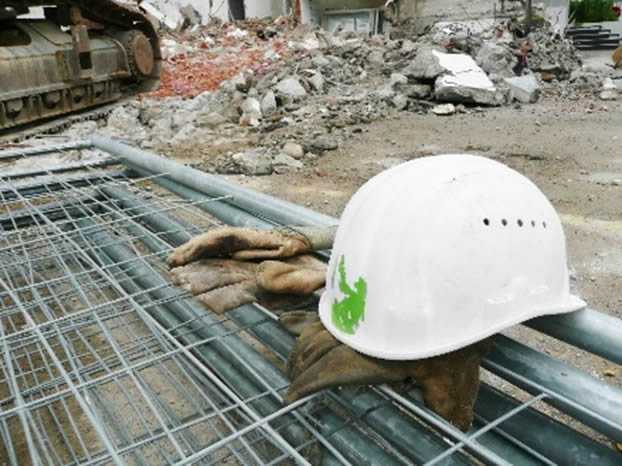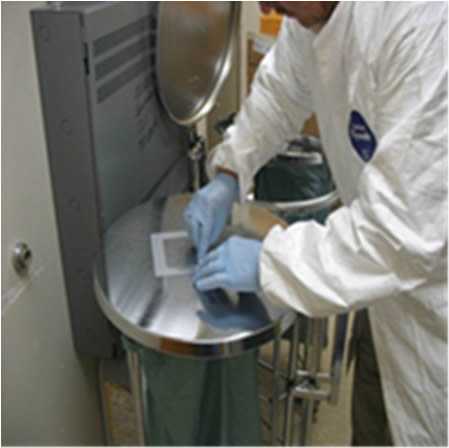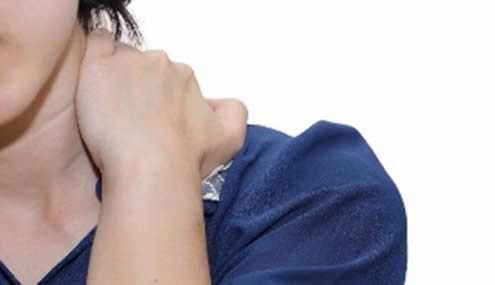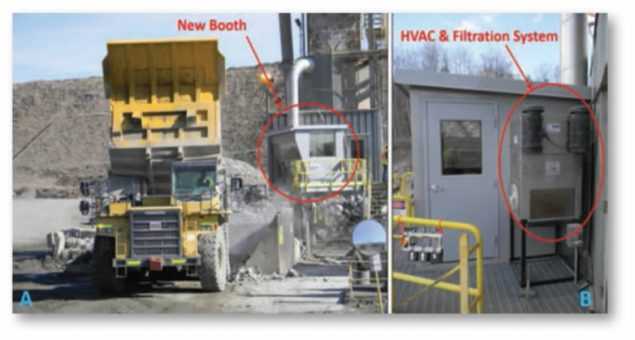NIOSH Research Rounds
NIOSH Research Rounds is a monthly bulletin of selected research at the National Institute for Occupational Safety and Health.
Volume 2, Number 2 (August 2016)
New Rock-crusher Booth Protects Against Airborne Pollutants
In the 1960s cartoon The Flintstones, Stone Age man Fred Flintstone worked in a quarry while sitting in the open booth of a rock-crusher machine. Presumably, the animators based Fred’s booth on the open designs typical of the 1960s. If they had created it in the 2000s, however, Fred’s booth would have looked vastly different, notwithstanding the fact that his booth was atop a brontosaurus.
Modern-day enclosed, climate-controlled booths are a prime example of prevention through design, one of the approaches that the National Institute for Occupational Safety and Health (NIOSH) recommends for developing safe, healthy, and comfortable work environments. Today’s booths have heating, ventilation, and air conditioning (HVAC) systems with built-in air pressurization and filtration units to remove airborne pollutants such as silica dust from rock and sand and particles from diesel exhaust. Removing these airborne pollutants is critical to protecting workers from developing silicosis, lung cancer, and other job-related lung diseases, which are preventable by reducing job-related exposures to respirable silica dust.
In a recent study, NIOSH investigators worked with industry partners at 3M Company to design and test an environmentally controlled booth for workers who operate rock crushers at the company’s Wausau granite quarry near Wausau, Wisconsin. Previously, the Wausau quarry had used an older crusher booth without HVAC or air filtration and pressurization systems. Based on specifications from previous NIOSH research, 3M designed and installed a new booth with full HVAC and filtration and pressurization systems. Compared to the old booth, the new one provided significantly greater protection against respirable rock dust, the investigators reported in a paper published in the peer-reviewed journal Mining Engineering. In addition, they found that increased filtration of the recirculated airflow markedly improved the booth’s effectiveness at protecting the operator from airborne pollutants.
More information is available:
Disclaimer: Mention of any company name, product or software does not constitute endorsement by NIOSH.
In This Issue
NIOSH Research Rounds is Brought to You By:
- John Howard, M.D., Director
- Fred Blosser, Editor in Chief
- Anne Blank, Story Editor
- Tanya Headley, Contributing Editor
- Cathy Rotunda, Copy Editor
- Glenn Doyle, Technical Lead
- Tonya White, Technical Support
Get Email Updates
Subscribe to the NIOSH Research Rounds Newsletter:
Most Traumatic Brain Injury Deaths in Construction are Due to Falls

From 2003 to 2010, 2,210 construction workers died from work-related traumatic brain injury (TBI), usually as the result of a fall from a height. Photo from Thinkstock.
The next time you see construction workers on scaffolding or a roof tens of feet above the ground, bear in mind that their occupation is one of the most dangerous in the country. From 2003 to 2010, 2,210 construction workers died from work-related traumatic brain injury (TBI), usually as the result of a fall from a height, according to a recent study at the National Institute for Occupational Safety and Health (NIOSH).
The first step in preventing deaths from TBI is to identify, and then control, risks. Since current research on work-related TBI is limited, NIOSH investigators wanted to identify the major risks to workers in the construction industry. To identify these risks, they analyzed data on TBIs from the Bureau of Labor Statistics Census of Fatal Occupational Injuries and reported their findings in the peer-reviewed American Journal of Industrial Medicine. They found that some construction workers were at greater risk of dying from a TBI than others. Specifically, the risk of dying from a TBI varied according to sex, age, country of birth, occupation, and size of the construction company:
|
Sex |
The greatest risk was among male workers. Men were 7 times more likely than were women to die from a TBI. |
|
Age |
The greatest risk was among older workers. Compared to younger workers aged 25 to 34 years, workers 65 years and older were almost 4 times more likely to die from a TBI. |
|
Country of Birth |
The greatest risk was among foreign-born workers, who were significantly more likely than native-born workers to die from a TBI. |
|
Occupation |
The greatest risk was among structural iron and steel workers and roofers. In these occupations, fall-related TBIs were the leading cause of death. |
|
Size of Company |
The greatest risk was among workers in small construction companies employing fewer than 20 employees. Compared to workers in larger companies with 100 or more employees, those in small companies faced a 2.6 times greater risk of death from a TBI. |
According to the investigators, safety interventions, especially among the most vulnerable, are necessary to reduce fall-related TBIs among construction workers. To address the need for safety interventions, NIOSH partnered with the Occupational Safety and Health Administration (OSHA) and CPWR—The Center for Construction Research and Training to promote the Safety Stand-Down, a nationwide construction falls-prevention campaign. Now in its third year, the campaign seeks to raise awareness by encouraging everyone in construction to work safely and use the right safety equipment while working at heights, such as on roofs, ladders, and scaffolds. In addition to the campaign, NIOSH also developed the Ladder Safety smartphone app, which prevents falls from ladders by providing visual and audio signals as well as safety tips for safe extension ladder positioning. The app is available for free download from the NIOSH website, Fall Injuries Prevention in the Workplace.
More information is available:
- Fatal Traumatic Brain Injuries in the Construction Industry, 2003–2010
- Traumatic Brain Injuries in Construction
Method Helps Protect Healthcare Workers from Hazardous Drugs

Surface wipe sampling, shown in the image above, is an important component of a comprehensive drug-safety program to identify where skin exposure to hazardous drugs could occur in healthcare settings. Photo from Tom Connor, NIOSH.
All drugs carry risks, as well as benefits, as the patient warnings listed on the accompanying inserts indicate. One class of drugs with especially serious risks are anticancer drugs, which can be associated with organ damage, reproductive harm, hearing impairment, and cancer. For patients who need these drugs for treatment, the benefits often outweigh the risks.
For healthcare workers, however, it is critical to prevent possible exposures through a comprehensive drug-safety program that includes a method called surface wipe sampling. Studies show that healthcare workers face exposure to anticancer and other hazardous drugs, most often through skin contact, although accidental inhalation and ingestion also can occur.
To summarize the current state of surface wipe sampling in healthcare and to provide basic guidance, investigators at the National Institute for Occupational Safety and Health (NIOSH) with university and business partners recently reviewed published studies.
To prevent exposure to hazardous drugs, it is important to first identify contaminated surfaces through surface wipe sampling, they report in the peer-reviewed Journal of Occupational and Environmental Hygiene. This method involves using special wipes to test workplace surfaces and then sending the wipes to a lab that analyzes them for the presence of hazardous drugs. Based on their review, the investigators recommend surface wipe sampling as an important component of a comprehensive drug-safety program to identify where skin exposure to hazardous drugs could occur. Although there are no guidelines for permitted levels of hazardous drugs, surface wipe sampling can disclose if a facility’s levels are high, compared with those of similar facilities. Most importantly, healthcare organizations can use the results of surface wipe sampling to evaluate the effectiveness of their drug-safety programs in reducing the risk of skin contact with hazardous drugs.
More information is available:
- Surface Wipe Sampling for Antineoplastic (Chemotherapy) and Other Hazardous Drug Residue in Healthcare Settings: Methodology and Recommendations
- Safe Handling of Hazardous Drugs
- Occupational Exposure to Antineoplastic Agents And Other Hazardous Drugs
- Hazardous Drug Exposures in Health Care
Neck Pain Linked to Psychosocial and Organizational Risks at Work

In the United States, neck pain and other injuries to the upper arms and back are the underlying causes of approximately one-third of injury-related lost workdays in manufacturing. Photo from Thinkstock.
If you have ever experienced persistent neck pain, you know that it can affect every aspect of daily life. Even simple tasks, such as walking, driving a car, or just sitting or lying down comfortably, can present a challenge when your neck hurts. In the workplace, neck pain can make it difficult or impossible to get the job done. Now, investigators at the National Institute for Occupational Safety and Health (NIOSH) with university partners have found a link between neck pain and specific psychosocial and organizational risks in the workplace.
In the United States, neck pain and other injuries to the upper arms and back are the underlying causes of approximately one-third of injury-related lost workdays in manufacturing. Across all industry nationwide, neck pain affects an estimated 15% of workers. At NIOSH, the causes and prevention of work-related neck pain and other muscle and bone injuries are research priorities.
In the current study, investigators found that neck pain was significantly more common among workers who reported one or more psychosocial and organizational risks in the workplace than it was among other workers. These risks included (1) work-family imbalance; (2) exposure to a hostile work environment and job insecurity; (3) non-standard work arrangements, such as contracting, consulting, on-call, or temporary work; (4) multiple jobs; and (5) long work hours. The investigators analyzed data from the 2010 National Health Interview Survey (NHIS). Administered by the Centers for Disease Control and Prevention, the NHIS collects health information through personal interviews from a representative sample of the U.S. population.
Intervention programs targeted to these specific risk factors for neck pain could benefit workers, according to the investigators. In addition, long-term studies of both psychosocial and physical risks for work-related neck pain are important to confirm these findings and identify other risk factors.
More information is available:
- Page last reviewed: August 17, 2016
- Page last updated: August 17, 2016
- Content source:
- National Institute for Occupational Safety and Health (NIOSH) Office of the Director


 ShareCompartir
ShareCompartir
